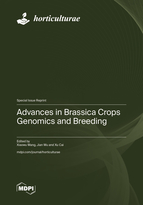Advances in Brassica Crops Genomics and Breeding
A special issue of Horticulturae (ISSN 2311-7524). This special issue belongs to the section "Genetics, Genomics, Breeding, and Biotechnology (G2B2)".
Deadline for manuscript submissions: closed (30 May 2022) | Viewed by 39053
Special Issue Editors
Interests: Brassica genomics and genetics; molecular breeding
Special Issues, Collections and Topics in MDPI journals
Interests: vegetable genetic breeding; genomics; genetic resources; molecular breeding
Special Issues, Collections and Topics in MDPI journals
Interests: pan-genome; genomics; genetics
Special Issues, Collections and Topics in MDPI journals
Special Issue Information
Dear Colleagues,
Brassica crops include vegetable, oil, ornamental and condimental crops. Many of these, such as Chinese cabbage, cabbage and rapeseed, are cultivated worldwide as important crops. Brassica species are unique not only because of their economic importance, but also because of the domestication of extreme morphological types, such as leafy heading, root/stem enlarging and florescence heading in these species. Moreover, Brassica species represent several important polyploidization events, including paleo-, meso- and present polyploidization, which make them ideal as model species for the investigation of polyploidization.
With the fast progress we are making in sequencing technologies, a number of genomes of Brassica crops species have been sequenced and high-quality chromosome scale assemblies were obtained. Moreover, the large-scale resequencing data of germplasm resources have been made available in B. rapa, B. oleracea, and B. napus, which allows GWAS and domestication analysis in these important crops. These breakthroughs accelerated the investigation into the genomics of the complex Brassica genomes, the evolution of different Brassica species, functional revealing of important genes, and the molecular marker-assisted breeding of Brassica crops. The purpose of this Special Issue is to present the recent advances in genomics and breeding in Brassica crops.
Prof. Dr. Xiaowu Wang
Prof. Dr. Jian Wu
Dr. Xu Cai
Guest Editors
Manuscript Submission Information
Manuscripts should be submitted online at www.mdpi.com by registering and logging in to this website. Once you are registered, click here to go to the submission form. Manuscripts can be submitted until the deadline. All submissions that pass pre-check are peer-reviewed. Accepted papers will be published continuously in the journal (as soon as accepted) and will be listed together on the special issue website. Research articles, review articles as well as short communications are invited. For planned papers, a title and short abstract (about 100 words) can be sent to the Editorial Office for announcement on this website.
Submitted manuscripts should not have been published previously, nor be under consideration for publication elsewhere (except conference proceedings papers). All manuscripts are thoroughly refereed through a single-blind peer-review process. A guide for authors and other relevant information for submission of manuscripts is available on the Instructions for Authors page. Horticulturae is an international peer-reviewed open access monthly journal published by MDPI.
Please visit the Instructions for Authors page before submitting a manuscript. The Article Processing Charge (APC) for publication in this open access journal is 2200 CHF (Swiss Francs). Submitted papers should be well formatted and use good English. Authors may use MDPI's English editing service prior to publication or during author revisions.
Keywords
- brassica
- marker-assisted breeding
- gene mapping
- QTL
- SNP
- GWAS
- genomics
- genome structure variation
- transcriptomics
- metabolomics








